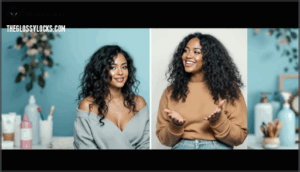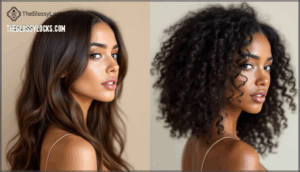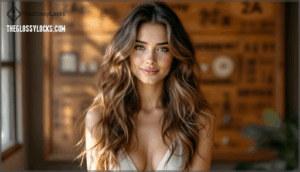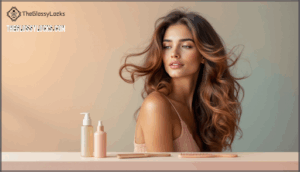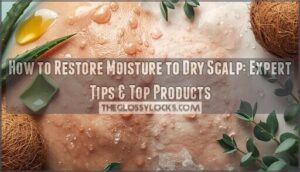This site is supported by our readers. We may earn a commission, at no cost to you, if you purchase through links.
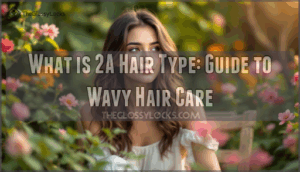
Most people with 2A hair struggle with the same frustrating paradox: their waves need moisture to stay defined, but too much product turns them limp and lifeless. The fine texture means oils travel down the hair shaft easily, keeping frizz at bay but also weighing down any volume you’re trying to build.
Understanding what makes 2A hair tick—from its oval-shaped follicles to its delicate protein structure—is the first step toward working with your natural texture instead of against it.
Table Of Contents
Key Takeaways
- 2A hair sits in the middle ground between straight and wavy, staying mostly flat at the roots before forming loose S-shaped waves toward the ends—it’s fine-textured and prone to getting weighed down by heavy products.
- The key to making 2A hair work is embracing lightweight products and minimal styling since the fine strands need moisture for definition but too much product kills volume instantly.
- Understanding that 2A differs from 2B and 2C (which have tighter, more defined waves starting closer to the scalp) helps you choose the right care routine instead of fighting your natural texture.
- Smart styling means air-drying when possible, using root-lift techniques for volume, and sticking with shoulder-length layered cuts that add movement without weighing down your waves.
What is 2A Hair Type?
So here’s the thing about 2A hair—it’s the gentlest wave on the spectrum, and understanding what that actually means will help you work with your hair instead of against it.
We’re going to break down exactly what makes 2A hair unique, how to spot it on your own head, and what’s actually happening at the science level. Let’s dig in.
Characteristics and Curl Pattern
Think of 2A hair as your hair’s version of a gentle ocean swell—it starts mostly straight at the roots, then transitions into soft, subtle waves as it moves down the length of your hair shaft. This is what makes 2A hair unique among wavy patterns.
Here’s what defines your 2A hair texture:
- Loose S-shaped waves that form toward the ends, creating a relaxed, beachy vibe without tight curl definition
- Minimal shrinkage from wet to dry, so what you see is pretty much what you get
- Fine, delicate strands with fewer protein cross-links, making them pliable but prone to weighing down with too much product
- Smoother cuticles that allow oils to spread easily, which keeps frizz at bay but demands lighter styling choices
- Natural volume challenges at the roots since your wave formation kicks in lower on the shaft, not at the scalp
Your hair’s freedom lies in embracing these characteristics rather than fighting them. The key is working with your natural curl pattern, not against it.
How to Identify 2A Hair
So how do you actually know if you’re working with 2A hair and not something else on the spectrum? Start with the wet hair test—wash your hair and let it air dry without touching it. True 2A hair sits mostly straight from roots to mid-length, then forms gentle waves toward the ends. You won’t see defined S-curves or tight curls. Look for that beachy, tousled texture rather than crisp wave pattern definition.
Check your hair shaft measurement too—2A usually ranges between 0.05–0.07mm in diameter, indicating finer strands. If your waves are loose and relaxed with minimal shrinkage from wet to dry, you’ve likely got 2A hair on your hands.
Scientific and Genetic Insights
Your hair’s wave pattern isn’t random—it’s written in your DNA. Your follicles are oval-shaped, which is genetically determined and produces that signature loose S-curve you’ve got. About 85–95% of your hair type comes down to heritability, meaning this is something you inherited. Variants in genes like TCHH control whether you end up wavy or straight.
The cellular structure of 2A hair has fewer protein cross-links in the cortex than curlier types, making your strands finer and more pliable. That’s why your waves respond so well to the right products and techniques—you’re working with your natural biology, not against it.
Understanding the genetic hair traits can help you better care for your specific hair type.
Distinguishing 2A Hair From Other Types
So you’ve got 2A hair and want to know how it stacks up against other wavy types? Smart move—knowing the difference between 2A, 2B, and 2C will completely change how you care for your waves.
Here’s what sets them apart and where your hair actually falls on the spectrum.
2A Vs 2B Hair Differences
You’re dealing with two entirely different beasts regarding 2A versus 2B hair. While both are wavy, your wave pattern, hair texture, and styling needs tell completely different stories. Here’s what sets them apart:
- Wave Pattern & Definition — 2A hair stays nearly straight at the roots with gentle waves appearing mid-length, while 2B shows well-defined "S" shapes closer to the scalp that maintain their shape without much fuss.
- Hair Texture & Thickness — 2A strands are fine and silky, making them easier to straighten but prone to breakage, whereas 2B is thicker and coarser with natural resilience.
- Frizz Control Reality — 2B hair battles frizz constantly due to its tighter texture blocking scalp oils, but 2A stays relatively sleek since oil travels down smoothly.
- Styling Needs & Products — 2A demands ultra-lightweight products to avoid flattening, while 2B thrives with hydrating, anti-frizz formulas to maintain definition and volume management.
The bottom line? 2A is your low-maintenance, flat-at-the-roots type that needs lifting, while 2B is your high-definition wave that craves moisture and frizz control. Understanding your hair type differences is essential for the right hair care approach.
2A Vs 2C Hair Differences
Now here’s where things get real: 2A and 2C hair are practically opposite ends of the wavy spectrum. Your 2A wave pattern stays loose and gentle, barely visible at the roots before becoming subtle waves mid-length. Meanwhile, 2C starts deep, defined S-shaped waves right from the scalp that maintain their curl definition naturally.
The texture difference? 2A is fine and lightweight, so heavy products flatten it instantly. 2C is thick and coarse—it actually absorbs richer conditioners without losing its shape. Frizz control matters differently too: 2A stays relatively sleek since oils travel down easily, but 2C battles constant puffiness in humidity because its raised cuticles trap moisture.
Your styling tips depend on this completely. 2A needs minimal product and quick air-drying to avoid weighing down. 2C demands leave-in conditioners and curl creams for definition. Understanding these differences means you’ll finally stop fighting your hair type and start working with it.
Overview of Wavy Hair Classifications
Now that you know how 2A stacks up against 2B and 2C, let’s zoom out and see where your hair actually fits in the bigger wavy-hair picture. The Andre Walker Hair Typing System breaks hair into four main categories: straight (type 1), wavy (type 2), curly (type 3), and coily (type 4).
Within wavy hair, you’ve got three subtypes—2A, 2B, and 2C—each with different wave patterns and curl classification levels. Your 2A falls at the loosest end, with gentle S-shaped wave patterns that originate from oval hair follicles.
Understanding this hierarchy helps you choose the right hair care approach for your specific texture.
Essential 2A Hair Care Techniques
Taking care of 2A hair isn’t rocket science, but it does require a different approach than straight or tightly curled textures. Your waves need the right balance of moisture, tender care, and smart product choices to look their best.
Here’s what you need to focus on to keep your 2A hair healthy and defined.
Cleansing and Conditioning Tips
Washing your 2A waves right isn’t rocket science, but it can be the difference between beachy excellence and a flat, greasy mess. Here’s your hair care routine breakdown:
- Gentle Shampoos Are Your Friend – Sulfate-free formulas cleanse without stripping natural hair moisture that keeps your waves bouncy.
- Skip Daily Washing – Every 1-2 days maintains scalp care without overdoing it.
- Condition Smart – Focus hydrating routines mid-length to ends, skipping roots to avoid weight-down.
- Weekly Moisture Masks – Deep hair conditioning and moisturizing treatments restore hair hydration without compromising volume.
Moisture and Protein Balance
Think of your 2A waves like a houseplant—too much food (protein) and they get brittle, too little water (moisture) and they wilt into frizz. Your hair porosity determines how well you lock in hydration levels.
If your strands feel limp, try protein treatments monthly. If they’re straw-like, boost moisturizing routines and skip sulfate effects that strip hair moisture.
Balance keeps your hair hydration and hair protein balance working together for healthy, bouncy waves.
Detangling and Brushing Best Practices
Your brush might be the quiet villain sabotaging your waves before they even have a chance to form. Wrong tools yank through delicate strands, creating frizz and snapping your texture into submission.
Here’s how to break free:
- Start at the ends with a detangling brush or wide-tooth comb, working up slowly—never rip from roots down
- Brush when damp (not soaking) with a leave-in conditioner for slip and frizz control
- Skip daily brushing when dry—finger-comb instead to keep your wavy hair pattern intact without destroying definition
Gentle combing protects your waves while tangle removal stays drama-free.
Managing Frizz and Enhancing Volume
If your 2A waves seem to have a mind of their own, you’re not alone. Frizz and flat roots are common frustrations, but they’re easier to fix than you might think.
Let’s break down what causes the chaos and how to tame it without losing your natural texture.
Causes of Frizz in 2A Hair
Frizz in 2a hair isn’t just bad luck—it’s science rebelling against you. When moisture balance goes awry, your hair cuticles lift like tiny protest signs, allowing humidity to sneak in and wreak havoc. Chemical damage, harsh water, and even towel-drying can rough up those delicate strands, making frizz control feel impossible.
Understanding hair porosity helps you fight back—damaged cuticles mean your strands can’t retain moisture properly, leaving you caught between too dry and too frizzy.
| Frizz Trigger | What’s Actually Happening |
|---|---|
| High Humidity | Your hair absorbs atmospheric moisture, swelling the shaft and creating that signature frizz halo—incidence jumps 20-30% above 70% humidity |
| Overwashing | Stripping natural oils more than three times weekly leaves wavy hair vulnerable and parched |
| Cuticle Damage | Color treatments or chemical processing raise cuticles by 54%, letting moisture flood in where it doesn’t belong |
| Hard Water | Mineral buildup blocks hydration and roughens cuticles by 27%, turning smooth waves into a tangled mess |
| Rough Treatment | Towel-drying and constant touching fragment cuticles, increasing frizz formation by 35% compared to gentle air-drying |
Air-Drying Vs Heat Styling
Once you’ve tamed the frizz, the real showdown begins: letting your waves do their own thing naturally or grabbing a hot tool to bend them to your will.
Air drying keeps your wavy hair healthier—no heat damage, no cuticle stress—and your natural wave pattern shines through. Heat styling with proper heat protectant gives you control and polish but risks long-term damage.
For frizz control and wave enhancement without compromise, air drying wins for everyday hair care.
Volumizing and Texturizing Methods
If your waves already fall naturally without heat, the next move is adding lift and definition—because flat roots and limp ends don’t do justice to 2A hair.
Try these hair styling techniques for enhancing hair volume:
- Root lift spray flipped upside down while damp
- Volumizing cuts with layers at eye level
- Texturizing products like mousse or dry shampoo mid-shaft
- Wave enhancement sprays scrunched into ends
These volumizing products and hair thickening tricks give you texture sprays’ magic without weighing down your waves.
Best Products and Styling Tips for 2A Hair
Finding the right products and styling approach for 2A hair doesn’t have to feel like guesswork. The key is working with your natural texture instead of fighting it—think lightweight formulas that won’t flatten your waves and techniques that bring out that relaxed, beachy vibe.
Let’s break down what actually works for keeping your hair healthy, defined, and full of life.
Lightweight Styling Product Recommendations
When your hair’s caught between straight and curly, the wrong product can flatten your waves faster than a rainstorm ruins a blowout—but the right lightweight formula sets them free. Look for hair serums and lightweight oils that glide through strands without weighing them down.
Mousse products and wave enhancers work wonders for styling 2a hair, adding bounce while taming flyaways. Wave spray breathes life into lazy bends, and frizz fighters keep things smooth without the crunch.
Achieving Beach Waves and Natural Texture
With the right products already in your arsenal, turning those gentle waves into that relaxed, just-left-the-shore look is easier than you’d think. Here’s your game plan for achieving beach waves without the sandy aftermath:
- Scrunch while damp – Work wave spray into wet hair, then scrunch upward to encourage natural volume and hair movement
- Air-dry for authenticity – Let your wavy hair dry naturally for that beachy texture without heat damage
- Sea salt spritz – Mist on texture spray mid-shaft to ends for enhanced wave enhancement and relaxed style
- Rough-dry technique – Flip your head and gently tousle while blow-drying on low for natural texture with extra body
Haircuts and Maintenance Routines
Your cut isn’t just about style—it’s the foundation that determines whether your waves cooperate or collapse by midday. Shoulder-length hair with layered haircut techniques adds natural body while preventing that weighed-down look.
Stick to trims every 10-12 weeks for routine maintenance that keeps split ends from sabotaging your wavy hair textures.
Between cuts, your hair care routine and daily upkeep matter just as much—think gentle detangling and moisture-focused hair care techniques that respect your wave pattern.
Frequently Asked Questions (FAQs)
What is a 2A hair type?
Think of your hair as nature’s way of drawing a soft, natural line between pin-straight and full-on curly—that’s Type 2A hair.
It’s the loosest wavy hair texture on the Curl Classification system, starting flat at your roots before forming gentle S-shaped waves near the ends.
What is type 2 hair?
Type 2 hair belongs to the wavy hair types category in curl pattern classification. It forms a natural S-shaped wave pattern, sitting between straight and curly textures in hair texture analysis based on follicle structure.
What is a good 2A hairstyle?
Shoulder-length hair with layered cuts brings out your natural texture beautifully. Long layers add movement, while side-swept bangs frame your face without weighing down wavy hair.
Wavy bobs work great too—they give structure and showcase those casual waves perfectly.
Is 2A hair straight or wavy?
Type 2A hair sits right in that ideal zone between straight and wavy. Your hair’s straight at the roots, then transitions into loose, gentle waves toward the ends—it’s wavy hair with minimal curl formation and subtle wave pattern that gives you that natural beachy vibe.
Is type 2A hair curly?
No—it sits right between straight and curly. Type 2A hair forms loose, gentle waves rather than defined curls.
The wave pattern creates natural movement without curl formation, giving you that effortlessly tousled texture. It’s wavy hair with minimal curl definition and subtle frizz control needs.
What is the difference between 2B and 2A hair?
The biggest difference lies in curl definition and wave pattern. 2B hair has tighter, more defined S-shaped waves that start closer to the roots, while Type 2A hair features looser waves that form mainly at the ends, staying flatter near your scalp.
Is 2A a good hair type?
Absolutely—it’s a dream for those craving freedom in their styling routine. Type 2A hair offers a natural volume boost and flexible styling options without demanding constant upkeep.
You get wavy hair advantages like easy texture and a low-maintenance style that conforms to whatever vibe you’re chasing.
What hairstyle is good for 2A type hair?
Layered cuts work beautifully—they add movement and prevent flatness. Shoulder-length hair with long layers showcases your natural waves without weighing them down.
Side swept bangs create dimension, while wavy bobs keep things fresh and manageable for easy beach waves.
How do I tell if I have 1C or 2A hair?
Look at how your strands behave when air-dried. Hair Texture Analysis shows 1C falls nearly straight with minimal bend, while Type 2A hair forms gentle S-waves at mid-lengths.
Wave Formation and Curl Pattern Identification reveal 2a hair’s beachy texture versus 1C’s subtle lift.
Is 2A hair thin or thick?
Hair density matters more than thickness here. Fine hair refers to the strand diameter—2A hair usually falls in that category, with delicate, pliable strands.
But thick texture? That’s about how much hair you’ve got. You can rock fine 2A waves with serious volume if your hair density is high.
Conclusion
Ironically, the hair type most people dismiss as ‘not wavy enough’ might be the most adaptable of all—if you stop fighting it. Your 2a hair type thrives when you embrace its lightweight nature instead of piling on heavy creams meant for tighter curls.
Think of it as controlled rebellion: a little texture spray here, some strategic scrunching there, and suddenly you’ve got movement without the frizz. The secret isn’t more product—it’s smarter choices that let your natural bends do what they already want to do.

